Systems, material, trimming forces: Everything about base plates and extensions
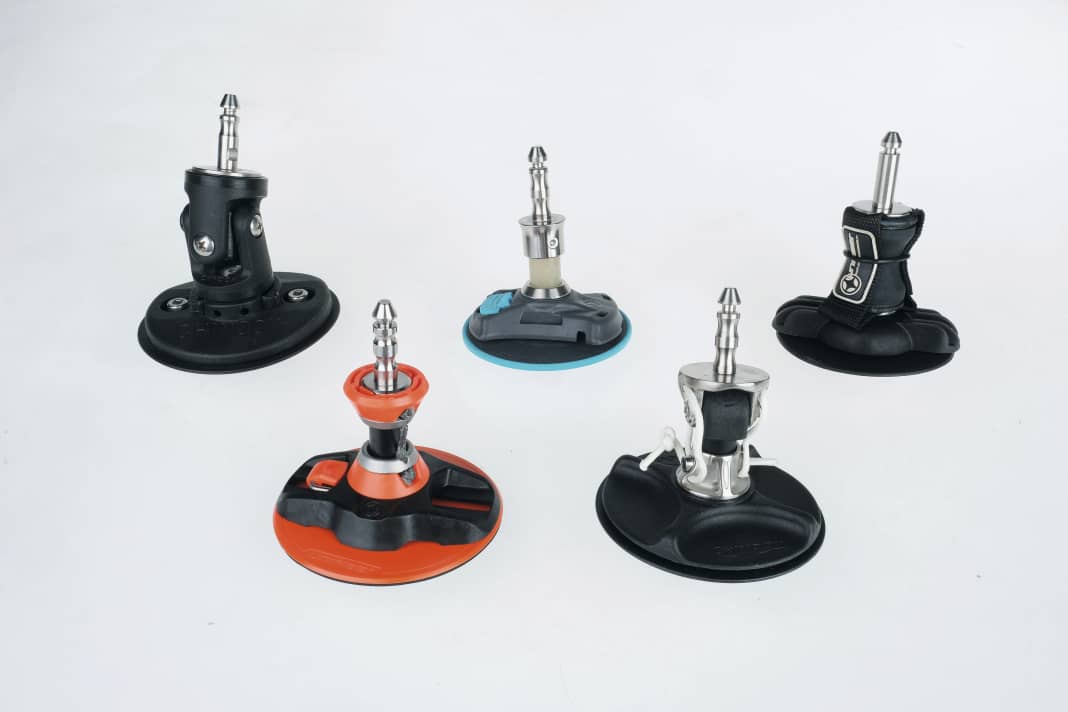





Swap boards quickly. Sounds easy and is usually possible since almost all surfers use the (Euro) pin. Apart from that, perhaps you want the right chord or gimbal, the optimum base plate and an extension to minimise trim forces? We have tested a wide variety of constellations here and have come up with some amazing results.
Tendon, power joint - or gimbal?
According to the oral tradition of surfing ancestors, the good old power joint comes from the automotive industry as an engine mount. The power joint is very robust and durable, but at some point - after many years of use - it is very difficult to replace. The screw connections are extremely tightly glued and have to be boiled out. A new purchase of the entire base plate often makes more sense. The pin is screwed to the power joint with an M8 or M10 thread. The M8 diameters rarely used today have broken off in the past, which was not good for the image. Because the safety strap runs underneath the pin, it was ineffective in this case. In contrast, the M10 threads that are now predominantly used are inconspicuous. Nevertheless, the so-called tendon joint has now become established.
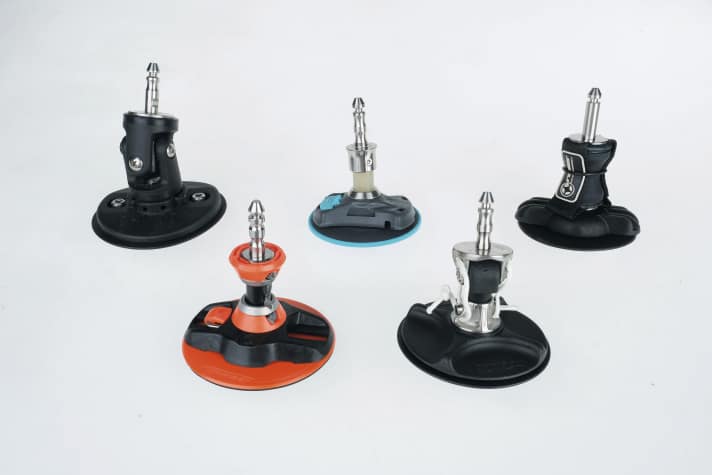
The massive gimbal is particularly popular with surf schools. During lessons, the sails are often in the water for a long time, whereby the continuous bending of the tendon joint places a particularly high load on it. However, most mast foot protectors do not fit well over it and the damping between the rig and board is zero. The thicker power joint made of softer rubber also withstands the permanent bending longer than the stiffer tendon. For private use, the half-cardan from Chinook with replaceable tendon is an alternative: for children, for wide foil boards and inflatable wind SUPs.
Base plate tendon: colour and shape
The interchangeable tendon ("tendon joint") is predominantly black or almost transparent, but also sometimes milky white or yellow (streamlined). The holes also differ: both in diameter and in the distance to the end of the string and in the arrangement (parallel or rotated 90 degrees). The position and diameter should match when swapping, but there is a tendency with the colour: black chords are often somewhat softer and less brittle at cold temperatures. The influence of temperature can be clearly felt: at room temperature, our test joint was still quite pliable, while the identical model was comparatively bumpy after a night at seven degrees in the fridge. When winter surfing, the condition should therefore be checked more frequently, even in the invisible areas. This can be done in five to ten minutes, even on models with screws; on the Unifiber Elite, the inner workings can even be checked on the beach without tools (click here for a detailed test). Obviously, there were no car designers at work here who would accept the complete removal of the engine for a clutch change.
Trimming forces: not a question of price
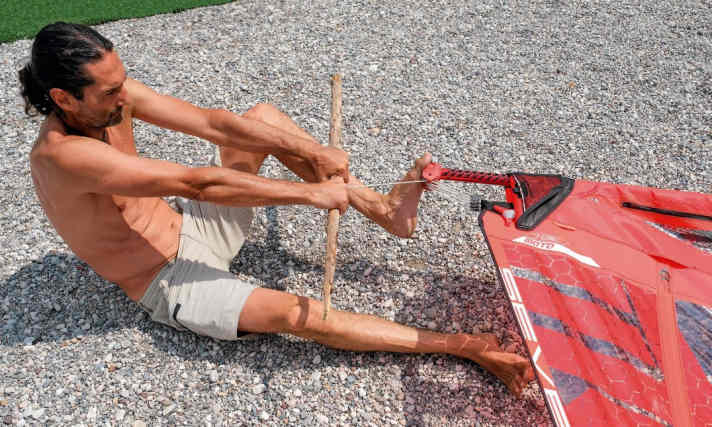
The smooth, white Dyneema rope is part of many expensive extensions, just like the leather steering wheel is part of the "Edition" equipment at VW. In an in-house comparison, this shines on the more expensive Gun extension, as does the chic roller bracket, the length adjustment is much more elegant and better solved than on the economy model, the overall impression is more solid and of higher quality. However, this makes little difference to the measured trimming forces. In the test cellar, we measured 78 kilos of pull on the GA Matrix 7.7 reference sail with the inexpensive Classic extension (49.90 euros). With the classy GunSails Pro XT (85.90 euros), the same simple trim ramps even add two kilos to the clock - which could also be due to the slightly different luff. Because now comes the surprise: when using the smooth Marlow formuline rope (GunSails, 3 euros/metre), the scales for both models remain exactly at 61 kilos.
No difference between the extensions, but around 20 kilos less thanks to a different rope? We put it to the test. Even with the Duotone Uni.XT, the trim forces with the rough series ropes are 82 kilos, with Dyneema tuning it is significantly lighter at just 65 kilos. Last test: NeilPryde UXT vs. MXT. Here, too, the picture is at least similar: for the NeilPryde V8, with a bearish pull on the luff, almost exactly the same trim force is required on both extensions. A smooth rope saves a good ten kilos. However, there are two disadvantages to Dyneema ropes: The ends cannot be welded well (tip: shrink a short piece of heat-shrinkable loop from the DIY store onto the end over a flame) and the smooth line constricts more when pulled by hand.
If it's all about the trimming forces, a smooth rope is more effective than the most expensive extension."
The last attempt to outwit physics with its incalculable frictional forces is the Severne extension with three pulleys at the bottom and a block of four on the sail. The moto requires over 90 kilos of pull, and the fourth pulley should - theoretically, without friction - halve the pulling force again. And here's the kicker: using only three pulleys on the sail only increases the pulling force by around five to ten kilos, the gain from the fourth pulley is obviously very small due to friction effects. The sophisticated Duotone Power.XT achieves more.
The GA Matrix requires 17 kilos of traction in the centre of the lever (11 at the end of the lever). You don't push it with your legs, but it is still fairly relaxed from the wrist. Severne has one last speciality in its range for smaller sails: the Cyclops is only "looped" through the block, so it only uses two pulleys, but a grippy pull loop should make it easier to push through. Surprisingly, the pulling force on a Severne Gator 6.5 only varies between 59 and 62 kilos: the Cyclops (59 kilos) requires the least pulling force. With three pulleys on the sail, 62 kilos are required. Geometry and friction are obviously much more efficient with the Cyclops.
Conclusion: In order to trim with as little effort as possible, the sail is the most important factor. Here the pulling forces differed enormously in some cases. We will therefore also measure the trimming forces on all sails in future sail tests. In the eagerness to save power, it should not be forgotten that trimming only takes a few seconds, whereas in the best case scenario the sail will be surfed for a whole day. Expensive extensions in particular have many advantages. If it is only a question of reducing the trimming forces, they do not automatically bring an advantage. The most favourable optimisation is a low-friction Dyneema rope. We achieved the worst result with an old Arrows extension with very small plastic pulleys. With a pull of well over 160 kilos, the reference sail could still not be trimmed to the maximum.
Permanently mounted base plates
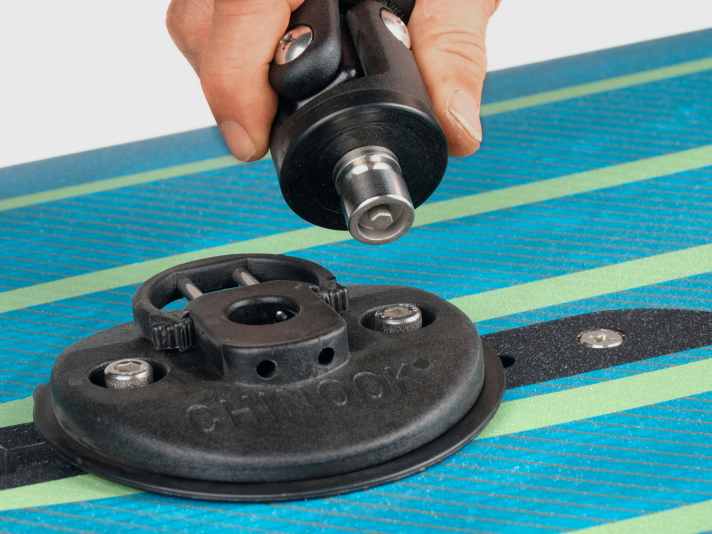
"Can you unscrew the base plate?" It's not just children who ask this question. The standard mast foot has to be tightened with a lot of finger strength and after surfing - especially with cold fingers - it feels twice as tight as before. Even in the surf test team, the perception of "tight" is very different: What one person would describe as "hand-tightened", the next person can hardly get it down again after changing the board. As a solution to this - and also as a convenient alternative - flat plates are available that remain permanently on the board and are connected to the power joint via an additional plug-in connection with a locking spring. In many cases, the board can also remain mounted in the board bag and on low shelves. This means that once you have found the optimum position, it will remain there and installation is much quicker and easier every time.
While the Duotone and Unifiber models are traditionally screwed on by hand, the Chinook version is fastened with two solid Allen screws. The matching Allen key is integrated into the mast spigot, allowing the plate to be screwed on easily and securely. However, 3.8 centimetres of adjustment range is lost at the front and rear of the mast track with the double screw connection. This range is not usually used for normal length mast tracks. With special, short mast tracks (Starboard Futura, for example), this could set undesirable limits. The long Chinook spigot is anchored particularly deeply due to the missing centre screw.
You will find a suitable chord or joint and the ideal mast base plate for every application."
Three different connections: US-Quickrelease, Euro-Pin and MTX
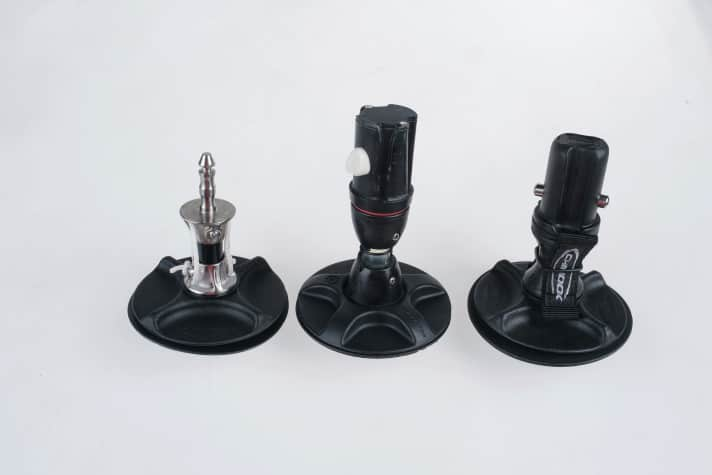
The US quick release with the two push buttons on the side is the ancestor of all systems, the (Euro) pin came onto the market much later as an alternative and NeilPryde wanted to combine the advantages of both systems with the MTX at some point.
With the US quick release with two side press studs, you can reliably check whether the connection is fully engaged before surfing. On the other hand, it is generally possible that a pin connection is not or not fully engaged. However, you can usually hear and feel the sliding spring engage in the pin, and the secure fit can also be checked by pulling. On some pin models, such as the S4LT (page 41 above), the spring is not actuated by a push button, but is pushed in from the outside - this is less convenient, but you are always on the safe side.
The pin is compatible with each other, with one known exception. Particularly long pins (alternatively available from Ascan or GunSails) are easier to insert, especially on the water, but with most thin RDM extensions the hole is too short. The only thing that helps here is to use a hacksaw.

